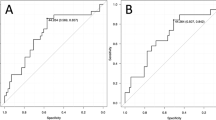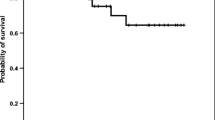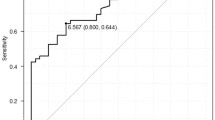Abstract
Purpose
The objective of this study is to establish the clinical utility of serum soluble IL-2 receptor (sIL-2Rα) and B2-Microglobulin (B2-M) as markers for diagnosis, prognosis and treatment monitoring in childhood soft tissue sarcomas (STS).
Methods
sIL-2Rα and B2-M were measured prospectively before treatment, in complete remission (CR) during and after therapy and at relapse by ELISA in 35 children with STS and in 50 healthy controls (once).
Results
The sIL-2Rα correlated with age thus it was presented as multiplication of the upper normal range for age. Pre-treatment level of sIL-2Rα but not of B2-M exceeded significantly that of healthy children. SIL-2Rα levels were significantly increased in patients with advanced stages, poor-risk histology and non-responders. Patients’ age >10 years, unfavourable tumour localisation and incomplete resection were not accompanied by the increase of any marker. Good response to chemotherapy was paralleled by a decline of sIL-2Rα pre-treatment level (P < 0.001). None of the markers predicted event-free and overall survival. At relapse, sIL-2Rα increased; however; it was not statistically different from the level stated in remission. Monitoring of B2-M during therapy did not reflect the disease course. After completion of therapy the levels of sIL-2Rα and B2-M were significantly lower than during treatment, but still higher than in controls.
Conclusions
sIL-2Rα was proven to be a promising marker for diagnosis and treatment monitoring in children with STS. It correlated also with some clinical variables known to have important prognostic role (STS stage, histological subtype and response to therapy); however, it failed to predict EFS and OS. To the contrary, B2-M proved to have no clinical value in the diagnostics, prognostics and treatment monitoring in paediatric STS.




Similar content being viewed by others
References
Abdul M, Hoosein N (2000) Changes in beta-2 microglobulin expression in prostate cancer. Urol Oncol 5:168–172
Akhtar S, El Weshi A, Abdelsalam M, Hussaini H, Janabi I, Rahal M et al (2007) Primary refractory Hodgkin’s lymphoma: outcome after high-dose chemotherapy and autologous SCT and impact of various prognostic factors on overall and event-free survival. A single institution result of 66 patients. Bone Marrow Transplant 40:651–658
Bacci G, Ferrari S, Longhi A, Rimondini S, Versari M, Zanone A et al (1999) Prognostic significance of serum LDH in Ewing’s sarcoma of bone. Oncol Rep 6:807–811
Bacci G, Longhi A, Ferrari S, Briccoli A, Donati D, De Paolis M et al (2004) Prognostic significance of serum lactate dehydrogenase in osteosarcoma of the extremity: experience at Rizzoli on 1421 patients treated over the last 30 years. Tumori 90:478–484
Berghuis D, de Hooge AS, Santos SJ, Horst D, Wiertz EJ, van Eggermond MC et al (2009) Reduced human leukocyte antigen expression in advanced-stage Ewing sarcoma: implications for immune recognition. J Pathol 218:222–231
Bien E, Balcerska A (2004) Clinical significance of erythrocyte sedimentation rate, C-reactive protein and serum lactate dehydrogenase levels in the diagnosis, prognosis and treatment monitoring of children suffering from cancer. Med Wieku Rozw 8:1081–1089
Bien E, Balcerska A (2008) Serum soluble interleukin 2 receptor alpha in human cancer of adults and children: a review. Biomarkers 13:1–26
Bien E, Balcerska A, Ciesielski D (2004) Does beta-2 microglobulin measurement play role in diagnostics of childhood malignancies? Wiad Lek 57:8–11
Bien E, Balcerska A, Ciesielski D (2006) Diagnostic and prognostic significance of serum soluble interleukin 2 receptor in children with malignancies. Wiad Lek 59:10–15
Bien E, Balcerska A, Kuchta G (2007) Serum level of soluble interleukin-2 receptor α correlates with the clinical course and activity of Wilms’ tumour and soft tissue sarcomas in children. Biomarkers 12:203–213
Bodey B, Psenko V, Lipsey AL, Kaiser HE (1996) Soluble interleukin-2 receptors in sera of children with primary malignant neoplasms. Anticancer Res 16:219–224
Bourantas KL, Hatzimichael EC, Makis AC, Chaidos A, Kapsali ED, Tsiara S et al (1999) Serum beta-2-microglobulin, TNF-α and interleukins in myeloproliferative disorders. Eur J Haematol 63:19–25
Boyano MD, Garcia-Vasquez MD, Lopez-Michelena T, Gardeazahal J, Bilbao J, Canavate ML et al (2000) Soluble iuterlcukiu-2 receptor, intercellular adhesion molecule-1 and interleukin-10 serum levels in patients with melanoma. Br J Cancer 83:847–852
Brand JM, Schmucker P, Breidthardt T, Kirchner H (2001) Upregulation of IFN-gamma and soluble interleukin-2 receptor release and altered serum cortisol and prolactin concentration during general anesthesia. J Interferon Cytokine Res 21:793–796
Brunetti G, Bossi A, Baiardi P, Jedrychowska I, Pozzi U, Bacchella L et al (1999) Soluble interleukin 2 receptor (sIL2R) in monitoring advanced lung cancer during chemotherapy. Lung Cancer 23:1–9
Chronowski GM, Wilder RB, Tucker SL, Ha CS, Sarris AH, Hagemeister FB et al (2002) An elevated serum beta-2-microglobulin level is an adverse prognostic factor for overall survival in patients with early-stage Hodgkin disease. Cancer 95:2534–2538
da Costa CM, Lopes A, de Camargo B (2003) A simple cost-effective lactate dehydrogenase level measurement can stratify patients with Ewing’s tumor into low and high risk. Ann Oncol 14:656
Dorval G, Welsh KI, Nilsson K, Wigzell H (1977) Quantitation of β2-microglobulin and HLA on the surface of human cells. I. T and B lymphocytes and lymphoblasts. Scand J Immunol 6:255–263
Dubois SG, London WB, Zhang Y, Matthay KK, Monclair T, Ambros PF et al (2008) Lung metastases in neuroblastoma at initial diagnosis: a report from the International Neuroblastoma Risk Group (INRG) project. Pediatr Blood Cancer 51:589–592
Duffy MJ (2007) Role of tumor markers in patients with solid cancers: a critical review. Eur J Intern Med 18:175–184
Fabre-Guillevin E, Tabrizi R, Coulon V, Monnereau A, Eghbali H, Soubeyran I et al (2006) Aggressive non-Hodgkin’s lymphoma: concomitant evaluation of interleukin-2, soluble interleukin-2 receptor, interleukin-4, interleukin-6, interleukin-10 and correlation with outcome. Leuk Lymphoma 47:603–611
Frydecka I, Rusiecka M, Kuliczkowski K, Kornafel J (1996) Serum soluble interleukin 2 receptor α and soluble CD8 levels in patients with gynecological malignancies undergoing radiotherapy. Arch Immunol Ther Exp 44:123–126
Gatenby RA, Gillies RJ (2004) Why do cancers have high aerobic glycolysis? Nat Rev Cancer 4:891–899
Gowda A, Byrd JC (2006) Use of prognostic factors in risk stratification at diagnosis and time of treatment of patients with chronic lymphocytic leukemia. Curr Opin Hematol 13:266–272
Hafiz MG, Rahman MM, Mannan MA (2008) Serum lactate dehydrogenase as a prognostic marker of childhood acute lymphoblastic leukemia. Mymensingh Med J 17:169–173
Hsiao SH, Lee MS, Lin HY, Su YC, Ho HC, Hwang JH et al (2009) Clinical significance of measuring levels of tumor necrosis factor-alpha and soluble interleukin-2 receptor in nasopharyngeal carcinoma. Acta Otolaryngol 23:1–5
Huang A, Quinn H, Glover C, Henderson DC, Allen-Mersh TG (2002) The presence of interleukin-2 receptor alpha in the serum of colorectal cancer patients is unlikely to result only from T cell up-regulation. Cancer Immunol Immunother 51:53–57
Kallio JP, Tammela TL, Marttinen AT, Kellokumpu-Lehtinen PL (2001) Soluble immunological parameters and early prognosis of renal cell cancer patients. J Exp Clin Cancer Res 20:523–528
Karadeniz C, Oguz A, Citak EC, Uluoglu O, Okur V, Demirci S et al (2007) Clinical characteristics and treatment results of pediatric B-cell non-Hodgkin lymphoma patients in a single center. Pediatr Hematol Oncol 24:417–430
Karlsson FA, Groth T, Sege K, Wibell L, Peterson PA (1980) Turnover in humans of β2-microglobulin: the constant chain of HLA-antigens. Eur J Clin Invest 10:93–100
Kawashima O, Kamiyoshihara M, Sakata S, Endo K, Saito R, Morishita Y (2000) The clinicopathological significance of preoperative serum-soluble interleukin-2 receptor concentrations in operable non-small-cell lung cancer patients. Ann Surg Oncol 7:239–245
Kitagawa J, Hara T, Tsurumi H, Goto N, Kanemura N, Yoshikawa T et al (2009) Serum-soluble interleukin-2 receptor (sIL-2R) is an extremely strong prognostic factor for patients with peripheral T-cell lymphoma, unspecified (PTCL-U). J Cancer Res Clin Oncol 135:53–59
Klein B, Klein T, Figer A, Bleiberg M, Shapira J, Loven D et al (1991) Soluble histocompatibility antigen class I in breast cancer patients in relation to tumor burden. Cancer 67:2295–2299
Klingebiel T, Boos J, Beske F, Hallmen E, Int-Veen C, Dantonello T et al (2008) Treatment of children with metastatic soft tissue sarcoma with oral maintenance compared to high dose chemotherapy: report of the HD CWS-96 trial. Pediatr Blood Cancer 50:739–745
Kloor M, Michel S, Buckowitz B, Rüschoff J, Büttner R, Holinski-Feder E et al (2007) Beta2-microglobulin mutations in microsatellite unstable colorectal tumors. Int J Cancer 121:454–458
Komp DM, Shapiro E, McNamara J (1988) Soluble interleukin-2 receptor in childhood non-Hodgkin’s lymphoma. Blood 71:1172–1174
Komp DM, McNamara J, Buckley P (1989) Elevated soluble interleukin-2 receptor in childhood hemophagocytic histiocytic syndromes. Blood 73:2128–2132
Koscielniak E, Morgan M, Treuner J (2002) Soft tissue sarcoma in children: prognosis and management. Paediatr Drugs 4:21–28
Kuku I, Bayraktar MR, Kaya E, Erkurt MA, Bayraktar N, Cikim K et al (2005) Serum proinflammatory mediators at different periods of therapy in patients with multiple myeloma. Mediators Inflamm 3:171–174
Lehninger Al (2000) Organ interrelationships in the metabolism of mammals. In: Lehninger textbook of biochemistry, Worth, New York, pp 829
Lissoni P, Barni S, Rovelli F, Viviani S, Maestrono GJ, Conti A et al (1990) The biological significance of soluble interleukin-2 receptors in solid tumors. Eur J Cancer 26:33–36
Lotzniker M, Pavesi F, Marbello L, Moratti R (1988) Beta-2-microglobulin as a tumor marker in solid malignancies. Oncology 45:162–165
Luksch R, Sampietro G, Collini P, Boracchi P, Massimino M, Lombardi F et al (1999) Prognostic value of clinicopathologic characteristics including neuroectodermal differentiation in osseous Ewing’s sarcoma family of tumors in children. Tumori 85:101–107
Malaguarnera M, Di Fazio I, Ferlito L, Pistone G, Laurino A, Vinci E et al (2000) Increase of serum beta2-microglobulin in patients affected by HCV correlated hepatocellular carcinoma. Eur J Gastroenterol Hepatol 12:937–939
Molica S, Levato D, Cascavilla N, Levato L, Musto P (1999) Clinico-prognostic implications of simultaneous increased serum levels of soluble CD23 and β2-microglobulin in B-cell chronic lymphocytic leukemia. Eur J Haematol 62:117–122
Moritake H, Kamimura S, Akiyoshi K, Nagatoshi Y, Chuman H, Okamura J (2003) Prognostic significance of elevated lactate dehydrogenase and creatine kinase in patients with rhabdomyosarcoma. Med Pediatr Oncol 40:187–188
Nakase K, Tsuji K, Tamaki S, Tanigawa M, Ikeda T, Miyanishi E et al (2005) Elevated levels of soluble interleukin-2 receptor in serum of patients with hematological or non-hematological malignancies. Cancer Detect Prev 29:256–259
O’Shea D, Giles C, Terpos E, Perz J, Politou M, Sana V et al (2006) Predictive factors for survival in myeloma patients who undergo autologous stem cell transplantation: a single-centre experience in 211 patients. Bone Marrow Transplant 37:731–737
Ottaiano A, Leonardi E, Simeone E, Ascierto PA, Scala S, Calemma R et al (2006) Soluble interleukin-2 receptor in stage I-III melanoma. Cytokine 33:150–155
Panteli KE, Hatzimichael EC, Bouranta PK, Katsaraki A, Seferiadis K, Stebbing J et al (2005) Serum interleukin (IL)-1, IL-2, sIL-2Ra, IL-6 and thrombopoietin levels in patients with chronic myeloproliferative diseases. Br J Haematol 130:709–715
Parasole R, Izzo F, Perrone F, Pignata S, Galati MG, Leonardi E et al (2001) Prognostic value of serum miological Markers in patients with hepatocellular carcinoma. Clin Cancer Res 7:3504–3509
Pavlidis NA, Bairaktari E, Kalef-Ezra J, Nicolaides C, Seferiadis C, Fountzilas G (1995) Serum soluble interleukin-2 receptors in epithelial ovarian cancer patients. Int J Biol Markers 10:75–80
Pedersen LO, Hansen AS, Olsen AC, Gerwien J, Nissen Mh, Buus S (1994) The interaction between ß2-microglobulin (ß2 m) and purified class-I major histocompatibility (MHC) antigen. Scand J Immunol 39:64–72
Perez-Andres M, Almeida J, Martin-Ayuso M, De Las Heras N, Moro MJ, Martin-Nuñez G et al (2009) Soluble and membrane levels of molecules involved in the interaction between clonal plasma cells and the immunological microenvironment in multiple myeloma and their association with the characteristics of the disease. Int J Cancer 124:367–375
Pezzilli R, Billi P, Fiocchi M, Beltrandi E, Cappelletti O, Sprovieri G et al (1995) Serum β2-microglobulin in chronic diseases of the pancreas. Int J Pancreatol 17:161–166
Pui CH, Hudson M, Luo X, Wilimas J, Evans W, Crist WM (1993) Serum interleukin-2 receptor levels in Hodgkin disease and other solid tumors of childhood. Leukemia 7:1242–1244
Rasmuson T, Grankvist K, Ljungberg B (1996) Serum beta 2-microglobulin and prognosis of patients with renal cell carcinoma. Acta Oncol 35:479–482
Ray-Cocquard (2004) Ovarian germ-cell malignant tumors. Orphanet Encyclopedia
Rodríguez J, Conde E, Gutiérrez A, Lahuerta JJ, Arranz R, Sureda A et al (2007) The adjusted International Prognostic Index and ß-2-microglobulin predict the outcome after autologous stem cell transplantation in relapsing/refractory peripheral T-cell lymphoma. Haematologica 92:1067–1074
Rolland P, Deen S, Scott I, Durrant L, Spendlove I (2007) Human leukocyte antigen class I antigen expression is an independent prognostic factor in ovarian cancer. Clin Cancer Res 13:3591–3596
Ruka W, Rutkowski P, Kaminska J, Rysinska A, Steffen J (2001) Alterations of routine blood tests in adult patients with soft tissue sarcomas: relationships to cytokine serum levels and prognostic significance. Ann Oncol 12:1423–1432
Rutkowski P, Kaminska J, Kowalska M, Ruka W, Steffen J (2002) Cytokine serum levels in soft tissue sarcoma patients: correlations with clinico-pathological features and prognosis. Int J Cancer 100:463–471
Sabbioni ME, Siegrist HP, Bacchi M, Bernhard J, Castiglione M, Thürlimann B et al (2000) Association between immunity and prognostic factors in early stage breast cancer patients before adjuvant treatment. Breast Cancer Res Treat 59:279–287
Sakata H, Murakami S, Hirayama R (2002) Serum soluble interleukin-2 receptor (IL-2R) and immunohistochemical staining of IL-2R/Tac antigen in colorectal cancer. Int J Clin Oncol 7:312–317
Sandoval JA, Hoelz DJ, Woodruff HA, Powell RL, Jay CL, Grosfeld JL et al (2006) Novel peptides secreted from human neuroblastoma: useful clinical tools? Pediatr Surg 41:245–251
Seliger B (2005) Strategies of tumor immune evasion. BioDrugs 19:347–354
Shiraishi K, Sugita K, Inukai T, Iijima K, Tezuka T, Goi K et al (2000) Analysis of serum lactate dehydrogenase and its isozymes during administration of granulocyte colony-stimulating factor in children. Int J Hematol 72:194–199
Singhal S, Mehta J (2006) Multiple myeloma. Clin J Am Soc Nephrol 1:1322–1330
Solheim JC (1999) Class IMHC molecules: assembly and antigen presentation. Immunol Rev 172:11–19
Spunt SL, Skapek SX, Coffin CM (2008) Pediatric nonrhabdomyosarcoma soft tissue sarcomas. Oncologist 13:668–678
Stefanovic V, Mitic-Zlatkovic M, Ignjatovic I, Vlahovic P, Hadzi-Djokic J (1999) Beta2-microglobulin in patients with urothelial cancer. World J Urol 17:319–323
Tartour E, Mosseri V, Jouffroy T, Deneux L, Jaulerry C, Brunin F et al (2001) Serum soluble interleukin-2 receptor concentrations as an independent prognostic marker in head and neck cancer. Lancet 357:1263–1264
Tesarova P, Kvasnicka J, Umlaufova A, Homolkova H, Jirsa M, Tesar V (2000) Soluble TNF and IL-2 receptors in patients with breast cancer. Med Sci Monit 6:661–667
Waldmann TA (2002) The IL2/IL 15 receptor systems: targets for immunotherapy. J Clin Immunol 22:51–56
Waldmann TA (2007) Anti-Tac (daclizumab, Zenapax) in the treatment of leukemia, autoimmune diseases, and in the prevention of allograft rejection: a 25-year personal odyssey. J Clin Immuno 27:1–18
Wimazal F, Sperr WR, Kundi M, Vales A, Fonatsch C, Thalhammer-Scherrer R et al (2008) Prognostic significance of serial determinations of lactate dehydrogenase (LDH) in the follow-up of patients with myelodysplastic syndromes. Ann Oncol 19:970–976
Wu LJ, Chen KY, Chi KH, Chen SY, Liang MJ, Shiau CY et al (1998) The significance of soluble interleukin-2 receptor in monitoring disease relapse in patients with nasopharyngeal cancer. Jpn J Clin Oncol 28:729
Zhang Z, Zhang M, Garmestani K, Talanov VS, Plascjak PS, Beck B et al (2006) Effective treatment of a murine model of adult T-cell leukemia using 211At-7G7/B6 and its combination with unmodified anti-Tac (daclizumab) directed toward CD25. Blood 108:1007–1012
Conflict of interest statement
We declare that we have no conflict of interest.
Author information
Authors and Affiliations
Corresponding author
Additional information
An erratum to this article can be found at http://dx.doi.org/10.1007/s00432-009-0737-7
Rights and permissions
About this article
Cite this article
Bien, E., Rapala, M., Krawczyk, M. et al. The serum levels of soluble interleukin-2 receptor α and lactate dehydrogenase but not of B2-microglobulin correlate with selected clinico-pathological prognostic factors and response to therapy in childhood soft tissue sarcomas. J Cancer Res Clin Oncol 136, 293–305 (2010). https://doi.org/10.1007/s00432-009-0661-x
Received:
Accepted:
Published:
Issue Date:
DOI: https://doi.org/10.1007/s00432-009-0661-x




